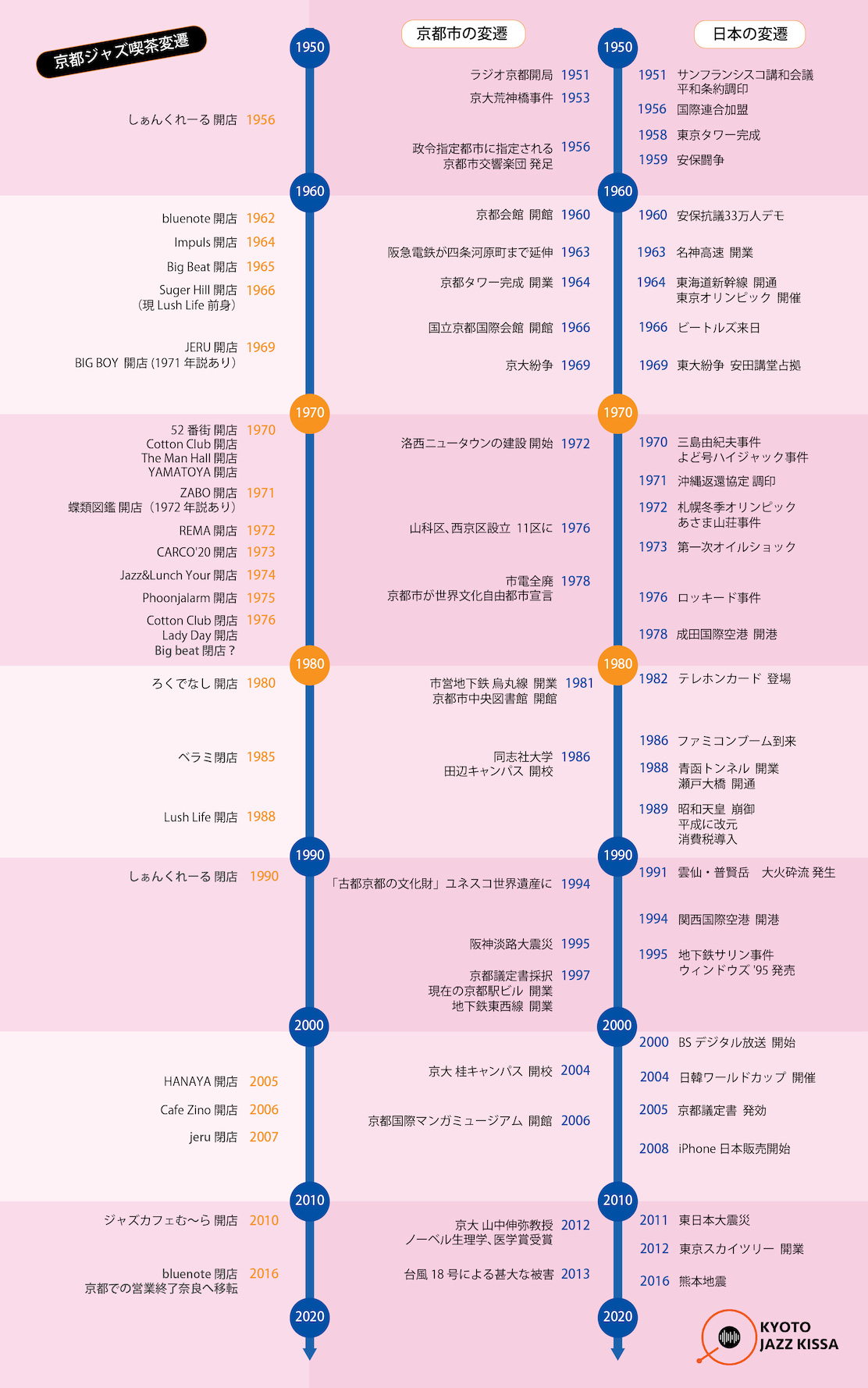「ジャズ喫茶最盛期知らない世代」が調べた京都ジャズ喫茶の歴史への考察
京都ジャズ喫茶マップ制作によせて
「ジャズ喫茶」今日では日本でもその道(どの道だ?)の人たちにしか通用しない単語かもしれない。
現在でも京都市内に数件あるジャズ喫茶。しかし、最盛期のジャズ喫茶とはまるで雰囲気が違うはずだし、それは時代の無常とも感じられる。私自身もその時代にジャズ喫茶を体験したことはもちろんなく、伝え聞いた話や各種記事、本の中に見る、私にとっては想像上、知識上の最盛期のジャズ喫茶がある。
この考察では、そんな「私」が本ウェブサイト制作のためのリサーチと京都ジャズ喫茶の変遷をまとめる中で「ジャズ喫茶最盛期知らない世代」による考えや妄想(?)を書き綴った自由考察である。
|はじめに|
様々な手法でのリサーチを経て、年表を作成してみる。結果一目瞭然で、京都では1960年代からジャズ喫茶という形態が創られ始め、1970年を境に加速度的な増加を辿る。この年表から想像すると1970年代が全盛期。おそらく1980年代まで。その後、1980年代後半から徐々に、90年代では急激に衰退していったと推察する。奇しくも、私は80年代後半から90年代がコドモ時代。
また、開店年の情報はあっても、どんなに探しても閉店年がさっぱり不明。今回の限られた時間でのリサーチでは、記述が見つからない店がほとんど。時代の変化と共にジャズ喫茶というブーム自体が自然消滅の方向性を辿り、閉店の時は随分ひっそりと人知れず終わっていったのだろうか?と想像する。
|各国の発展とジャズ喫茶と勢い|
1960年代より右肩上がりの経済や都市の発展・成長が明白で、この勢いのある時代性がブーム誕生、そして発展の後押しをしたことは想像に難くない。
終戦を迎え解禁になったアメリカ音楽が10年ほどをかけて、またじわじわと広まり始めたところに、ちょうど本国アメリカでビバップの流行からモダンジャズへの変化と最盛期を迎えながら、時を同じくして日本に入ってきたことが重要な要因の一つではないか?
「当時の若者にとっては最先端の流行洋楽だった」と当事若者だった音楽家の言。また、本国ではビバップの極みが頂点に達したかのように、違う表現を模索する世代が生まれ、モダンジャズ、そしてモード、フリーと1950年代から1970年頃まで音楽的に見ても多様な要素を生み出し、そんな、エネルギーがジャズ喫茶繁栄に多角的に影響しつつ、日本社会の現状の雰囲気とも合致し奇跡的な融合の結果の産物ではないか。
奇妙なことに、京都に「しぁんくれーる」が誕生した1956年に穐吉敏子が日本人で初めてバークリー音楽大学へ留学し、「bluenote」が誕生した1962年には次いで渡辺貞夫が留学している。
|ジャズの発展と鑑賞スタイルと時代性|
元々、スイング時代まではダンスミュージックの要素が強かったジャズが1940年代後期からビバップを経てモダンジャズと言われる時代に徐々にシフトし、インプロヴィゼーション(即興)の要素が強まり、その瞬間芸術的な側面を重要視する傾向が高まる。そういったジャズ自体の変遷もジャズ喫茶における日本独特の押し黙って真剣にジャズを聴くという(かなり個性的!)スタイルを促進させたのかもしれない。
1950年代後半からモダンジャズへの流れの中でヨーロッパでのジャズ熱も上がり、この世界的なシーンとジャズ自体の発展、日本のジャズ喫茶のスタイルなどが当時の時代性と奇跡的な融合を遂げたのでは?いや、融合が先か時代が先かは誰にも決定づけることができない。
ただ、私から見れば学生運動が盛んなその時代の日本や京都と押し黙ってレコードを聴くジャズ喫茶の鑑賞スタイル、マイルス・ディヴィス等の活躍による当時のジャズシーンとの親和性、絶妙なリンクがあるように感じるし、時代の象徴のように見える。
|学生の街とジャズ喫茶|
また、首都東京を除く他の都市と比べて京都でこれだけジャズ喫茶が繁栄したのには「学生の街」という地域特性も大きく影響していると考えられる。京都市は長らく人口100万人に対する大学数が全国1位。
前項でも触れた学生運動が盛んな、つまりエネルギッシュな学生が多く存在した1970年当時、市内に大学がすでに20以上あったと思われる。当時にはその影響が京都における学生運動の活発化だけでなく、ジャズ喫茶の繁栄という想定外の範疇に及び、結果「ジャズ喫茶」という文化の定着と繁栄にも一役買ったのではないか?
そして、大学入学のために各地から京都への人の流入、就職に伴う流出を繰り返すうちに京都での学生生活=青春時代をジャズ喫茶に通ったお客さん達が各地で語ることによって広範囲の周知をもたらし、出張や旅行で京都へ再訪する度に思い出のジャズ喫茶へ立ち寄ることで営業を支えてこられた。と言えるのではないか?
実際、現在はその世代であろう人物による京都のジャズ喫茶に関するブログや記事なども数多く散見される。私は、そういった行為全てを「ジャズ喫茶愛」と呼びたい。(勝手に笑)
このようなオンライン上のブログやコミニティースペースで、今でも熱く語られることによって、現在では数少なくなっても「ジャズ喫茶」という場所が現存し続け、その文化が継続する根源的エネルギーになっているのではないだろうか?
|おわりに|
時代や文化が様々に影響し日本独自の「ジャズ喫茶」が生まれ、時代性に拠って京都での最盛期を迎えたと推察するが、今回のリサーチで強く感じたのは、いつでもそこに生きている人々が集まり楽しむことによって支え続けたことが発展の最大の力だったのではないだろうか?ということ。
拘りの塊のようなマスターや個性的な店、そこに通ったクセのある人たち。(失敬…ご容赦を)
千差万別の愛すべき人々が、各々の手法でジャズやジャズ喫茶を好きだった。それが細くなっても現在でも続いている。
これからも、そんな「ジャズ喫茶愛」が生まれ続けることを願って締め括りとします。
そして、本ウェブサイトをリリースすることで、私のような否、もっと若い「ジャズ喫茶最盛期知らない世代」まで、ジャズ喫茶来訪のハードルが取り去られ「ジャズ喫茶」を楽しんでくださることを心より願って、この自由考察(独り言?)を締めくくりたいと思います。
読了ありがとうございました。
京都ジャズ喫茶マップ制作チーム 東條やすこ
2020年10月25日
The consideration about the history of Jazz Cafe in Kyoto, researched by “the generation who don't know the golden ages of Jazz Cafe.”
Message for Kyoto Jazz Cafe Map
These days, in Japan, “Jazz Cafe” could be known to only a few experts in that field (which field?)
There still remain several Jazz Cafes in Kyoto. However, their atmosphere should be completely different from before, which we could say is the mutability of ages. Of course, I also have never experienced Jazz Cafe at that time. So I just imagine the flourished Jazz Cafe by hearing stories, a lot of articles and books.
This consideration is just “my” idea and imagination(?), which I wrote while researching the transition of Jazz Cafe in Kyoto to make this website.
Introduction
We had researched in various methods, and made a chronological table. The result is quite obvious. In Kyoto, Jazz Cafe was established in the 1960’s, and the numbers increased rapidly from the 70’s. I guess from this chronological table, the 70’s was the golden ages of Jazz Cafe. Maybe, until the 80’s. After that, it declined slightly in the late 80’s, and significantly in the 90’s.
Besides, even if there is the information of the opening date, the closing date is uncertain at all. In this limited research, we couldn’t find descriptions of almost. I imagine the boom of Jazz Cafe ended gradually, and the cafes were closed in secret.
The development of countries and Jazz Cafe
It is obvious that economies and cities of each country were continuously growing from the 1960’s. So I imagine this energy boosted the birth and the development of Jazz Cafe.
The American music was lifted after World War II, and slowly spread out in Japan over 10 years. Just then, Jazz music was born from Bebop in its home country, America, and reaching the peak time, was brought to Japan and accepted by Japanese people.
The musician said, “Jazz was the latest music for young people in those days.” Like Bebop had reached the peak time in its home country, Modern, Mode, Free Jazz were invented from the young seeking new expression. They made various music elements one another one from the 50’s to 70’s. I guess that energy affected the prosperity of Jazz Cafe multi-directionally, and matched with the mood of Japanese society miraculously.
Add to that, Toshiko Akiyoshi, a Jazz pianist, went to Berklee College of Music to study as the first Japanese in 1956 when “Champ Clair” opened in Kyoto. Then, Sadao Watanabe, a saxophone player, went to study music in 1962 when “blue note” opened.
Development of Jazz, listening style and disposition of the time
Originally, until the time of Swing, Jazz seemed like Dance music. From the late 1940s, it gradually changed to Modern Jazz through Bebop, and improvisation and its artistic aspect became more popular and important points. Such a change of Jazz might help to make Japan’s own style of listening to Jazz quiet in Jazz Cafe. (It’s so unique!)
From the late 50’s, among the flowing to Modern jazz, Jazz fever also rose in Europe. This worldwide Jazz scene, the development of Jazz and the unique style of Jazz Cafe in Japan were miraculously fused with the disposition of those days, weren’t they? Well, no one can decide whether fusion was first or times was first.
Though this is my personal thought, Japan and Kyoto of that era when the student movement flourished, the silent listening style of records in Jazz Cafe, Jazz Scene made by Miles Davis etc. seem to link each other and symbolize the times.
The student’s quarter and Jazz Cafe
On the other hand, I guess Jazz Cafe flourished in Kyoto more than other cities except Tokyo because of its regional characteristics, “the student’s quarter.” The number of universities for 1 million people in Kyoto has been the most in Japan for a long time.
As mentioned above, in the 1970’s, the student movement flourished in Kyoto. That is, many energetic students lived there. And, there were already more than 20 universities in the city. So I think these effects caused not only the activation of the student movement, but also the establishment and prosperity of the culture, “Jazz Cafe.”
Also, within repeating inflow to matriculate and outflow to get employment, who spent student life (=springtime) in Kyoto talk about that in each place, therefore Jazz Cafe has been known widespread. Then, I wonder, when they come back to Kyoto for a business trip or travel, they visit Jazz Cafe of memories and have supported the cafes.
In fact, we can read a lot of personal blogs by the people of that generation now. I would like to name such actions “Jazz Cafe Love.” lol
By discussing enthusiastically in such blogs and community spaces online still now, even if the numbers decreased, Jazz Cafe has existed, and the Jazz Cafe culture has continued.
Conclusion
I guess ages and cultures affected each other and made Japan’s own “Jazz Cafe,” it reached the peak time by the flow of time. But, what I strongly feel in this research is that the biggest help for development was the support by people gathering at Jazz Cafe every time.
Stubborn owners, unique cafes, eccentric people going there. (I beg your pardon. Please forgive me.)
Various lovely people adored Jazz and Jazz Cafe in their own ways. It’s got thinner but continuing now.
In conclusion, I wish such “Jazz Cafe Lovers” would be born forever.
And I conclude this consideration (monologue?) that I hope from the bottom of my heart for such as me, no, much younger “the generation who don’t know the golden ages of Jazz Cafe” clear the hurdle to visit Jazz Cafe and enjoy it.
Thank you for your reading.
Yasuko Tojo from Production team of Kyoto Jazz Cafe Map
October 25th, 2020

